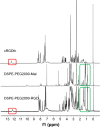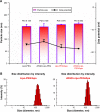Cyclic RGD peptide-modified liposomal drug delivery system for targeted oral apatinib administration: enhanced cellular uptake and improved therapeutic effects
- PMID: 28331317
- PMCID: PMC5354530
- DOI: 10.2147/IJN.S125573
Cyclic RGD peptide-modified liposomal drug delivery system for targeted oral apatinib administration: enhanced cellular uptake and improved therapeutic effects
Abstract
Apatinib is an oral tyrosine kinase inhibitor, which selectively targets vascular endothelial growth factor receptor 2 and has the potential to treat many tumors therapeutically. Cyclic arginylglycylaspartic acid (cRGD)- and polyethylene glycol (PEG)-modified liposomes (cRGD-Lipo-PEG) were constructed to act as a targeted delivery system for the delivery of apatinib to the human colonic cancer cell line, HCT116. These cRGD-modified liposomes specifically recognized integrin αvβ3 and exhibited greater uptake efficiency with respect to delivering liposomes into HCT116 cells when compared to nontargeted liposomes (Lipo-PEG), as well as greater death of tumor cells and apoptosis. The mechanism by which cRGD-Lipo-PEG targets cells was elucidated further with competition assays. To determine the anticancer efficacy in vivo, nude mice were implanted with HCT116 xenografts and treated with apatinib-loaded liposomes or free apatinib intravenously or via intragastric administration. The active and passive targeting of cRGD-Lipo-PEG led to significant tumor treatment targeting ability, better inhibition of tumor growth, and less toxicity when compared with treatments using uncombined apatinib. The results presented strongly support the case for cRGD-Lipo-PEG representing a targeted delivery system for apatinib in the treatment of colonic cancer.
Keywords: apatinib; cRGD; colorectal cancer; integrin αvβ3; targeted oral therapy.
Conflict of interest statement
Disclosure The authors report no conflicts of interest in this work.
Figures















Similar articles
-
Lipopepsomes: A novel and robust family of nano-vesicles capable of highly efficient encapsulation and tumor-targeted delivery of doxorubicin hydrochloride in vivo.J Control Release. 2018 Feb 28;272:107-113. doi: 10.1016/j.jconrel.2018.01.011. Epub 2018 Feb 2. J Control Release. 2018. PMID: 29355618
-
Cyclic RGD peptide-modified liposomal drug delivery system: enhanced cellular uptake in vitro and improved pharmacokinetics in rats.Int J Nanomedicine. 2012;7:3803-11. doi: 10.2147/IJN.S33541. Epub 2012 Jul 18. Int J Nanomedicine. 2012. PMID: 22888235 Free PMC article.
-
cRGD-functionalized reduction-sensitive shell-sheddable biodegradable micelles mediate enhanced doxorubicin delivery to human glioma xenografts in vivo.J Control Release. 2016 Jul 10;233:29-38. doi: 10.1016/j.jconrel.2016.05.014. Epub 2016 May 10. J Control Release. 2016. PMID: 27178807
-
cRGD functionalised nanocarriers for targeted delivery of bioactives.J Drug Target. 2019 Feb;27(2):111-124. doi: 10.1080/1061186X.2018.1473409. Epub 2018 May 23. J Drug Target. 2019. PMID: 29737883 Review.
-
[Elucidation for Intratumor Localization of a DDS-based Anticancer Drug and Enhancement of Its Therapeutic Effects via Improvement of the Tumor Microenvironment].Yakugaku Zasshi. 2021;141(11):1241-1245. doi: 10.1248/yakushi.21-00148. Yakugaku Zasshi. 2021. PMID: 34719544 Review. Japanese.
Cited by
-
Anticancer Efficacy of Targeted Shikonin Liposomes Modified with RGD in Breast Cancer Cells.Molecules. 2018 Jan 29;23(2):268. doi: 10.3390/molecules23020268. Molecules. 2018. PMID: 29382149 Free PMC article.
-
Bioactive Loaded Novel Nano-Formulations for Targeted Drug Delivery and Their Therapeutic Potential.Pharmaceutics. 2022 May 19;14(5):1091. doi: 10.3390/pharmaceutics14051091. Pharmaceutics. 2022. PMID: 35631677 Free PMC article. Review.
-
The Osteogenic Differentiation Effect of the FN Type 10-Peptide Amphiphile on PCL Fiber.Int J Mol Sci. 2018 Jan 4;19(1):153. doi: 10.3390/ijms19010153. Int J Mol Sci. 2018. PMID: 29300346 Free PMC article.
-
Liposomes and Extracellular Vesicles as Drug Delivery Systems: A Comparison of Composition, Pharmacokinetics, and Functionalization.Adv Healthc Mater. 2022 Mar;11(5):e2100639. doi: 10.1002/adhm.202100639. Epub 2021 Jun 24. Adv Healthc Mater. 2022. PMID: 34165909 Free PMC article. Review.
-
Monomethyl Auristatin E Grafted-Liposomes to Target Prostate Tumor Cell Lines.Int J Mol Sci. 2021 Apr 15;22(8):4103. doi: 10.3390/ijms22084103. Int J Mol Sci. 2021. PMID: 33921088 Free PMC article.
References
-
- Jiang Y, Lu J, Wang Y, et al. Molecular-dynamics-simulation-driven design of a protease-responsive probe for in-vivo tumor imaging. Adv Mater. 2014;26(48):8174–8178. - PubMed
MeSH terms
Substances
LinkOut - more resources
Full Text Sources
Other Literature Sources

